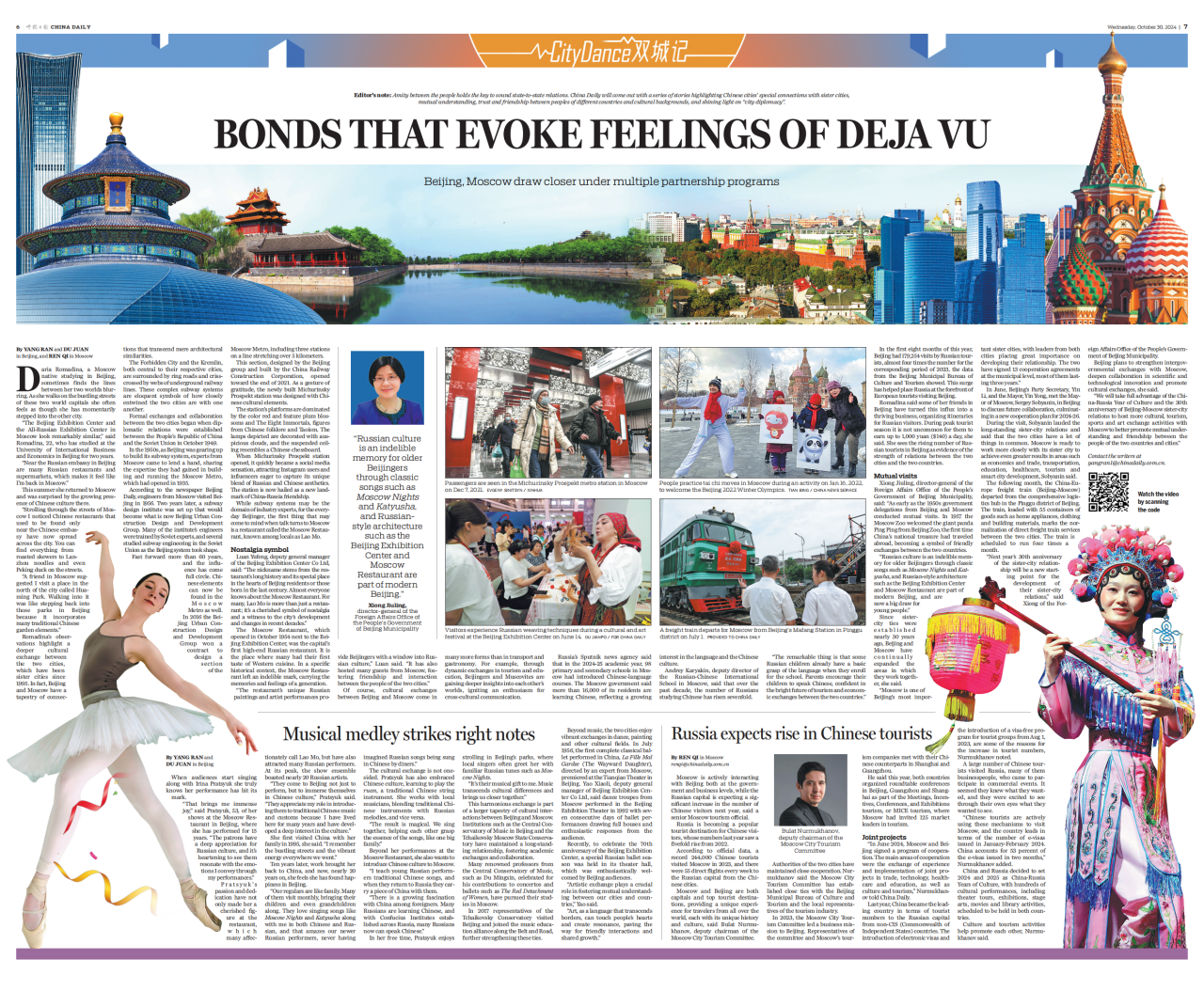Daria Romadina, a Moscow native studying in Beijing, sometimes finds the lines between her two worlds blurring. As she walks on the bustling streets of these two world capitals she often feels as though she has momentarily stepped into the other city.
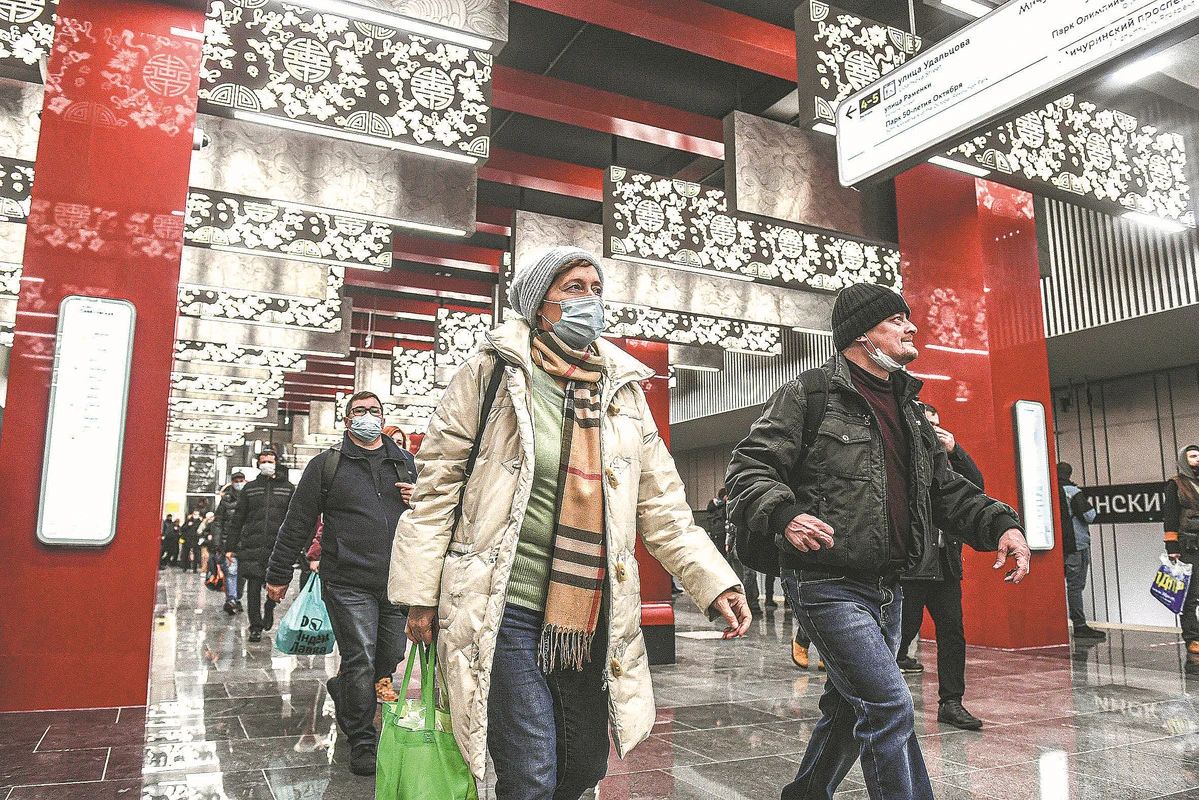
Passengers are seen in the Michurinsky Prospekt metro station in Moscow on Dec 7, 2021. EVGENY SINITSYN/XINHUA
"The Beijing Exhibition Center and the All-Russian Exhibition Center in Moscow look remarkably similar," said Romadina, 22, who has studied at the University of International Business and Economics in Beijing for two years.
"Near the Russian embassy in Beijing are many Russian restaurants and supermarkets, which makes it feel like I'm back in Moscow."
This summer she returned to Moscow and was surprised by the growing presence of Chinese culture there.
"Strolling through the streets of Moscow I noticed Chinese restaurants that used to be found only near the Chinese embassy have now spread across the city. You can find everything from roasted skewers to Lanzhou noodles and even Peking duck on the streets.
"A friend in Moscow suggested I visit a place in the north of the city called Huaming Park. Walking into it was like stepping back into those parks in Beijing because it incorporates many traditional Chinese garden elements."
Romadina's observations highlight a deeper cultural exchange between the two cities, which have been sister cities since 1995. In fact, Beijing and Moscow have a tapestry of connections that transcend mere architectural similarities.
The Forbidden City and the Kremlin, both central to their respective cities, are surrounded by ring roads and crisscrossed by webs of underground railway lines. These complex subway systems are eloquent symbols of how closely entwined the two cities are with one another.
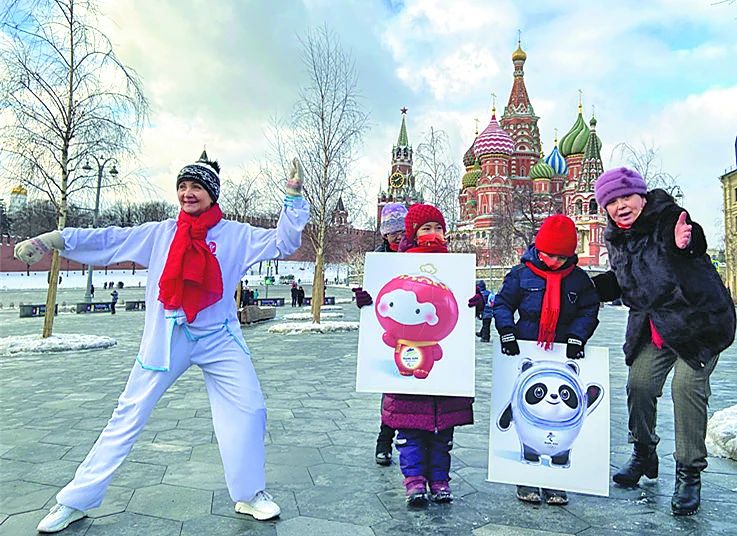
People practice tai chi moves in Moscow during an activity on Jan 16, 2022, to welcome the Beijing 2022 Winter Olympics. TIAN BING/CHINA NEWS SERVICE
Formal exchanges and collaboration between the two cities began when diplomatic relations were established between the People's Republic of China and the Soviet Union in October 1949.
In the 1950s, as Beijing was gearing up to build its subway system, experts from Moscow came to lend a hand, sharing the expertise they had gained in building and running the Moscow Metro, which had opened in 1935.
According to the newspaper Beijing Daily, engineers from Moscow visited Beijing in 1956. Two years later, a subway design institute was set up that would become what is now Beijing Urban Construction Design and Development Group. Many of the institute's engineers were trained by Soviet experts, and several studied subway engineering in the Soviet Union as the Beijing system took shape.
Fast forward more than 60 years, and the influence has come full circle. Chinese elements can now be found in the Moscow Metro as well. In 2016 the Beijing Urban Construction Design and Development Group won a contract to design a section of the Moscow Metro, including three stations on a line stretching over 5 kilometers.
This section, designed by the Beijing group and built by the China Railway Construction Corporation, opened toward the end of 2021. As a gesture of gratitude, the newly built Michurinsky Prospekt station was designed with Chinese cultural elements.
The station's platforms are dominated by the color red and feature plum blossoms and The Eight Immortals, figures from Chinese folklore and Taoism. The lamps depicted are decorated with auspicious clouds, and the suspended ceiling resembles a Chinese chessboard.
When Michurinsky Prospekt station opened, it quickly became a social media sensation, attracting Instagram users and influencers eager to capture its unique blend of Russian and Chinese aesthetics. The station is now hailed as a new landmark of China-Russia friendship.
While subway systems may be the domain of industry experts, for the everyday Beijinger, the first thing that may come to mind when talk turns to Moscow is a restaurant called the Moscow Restaurant, known among locals as Lao Mo.
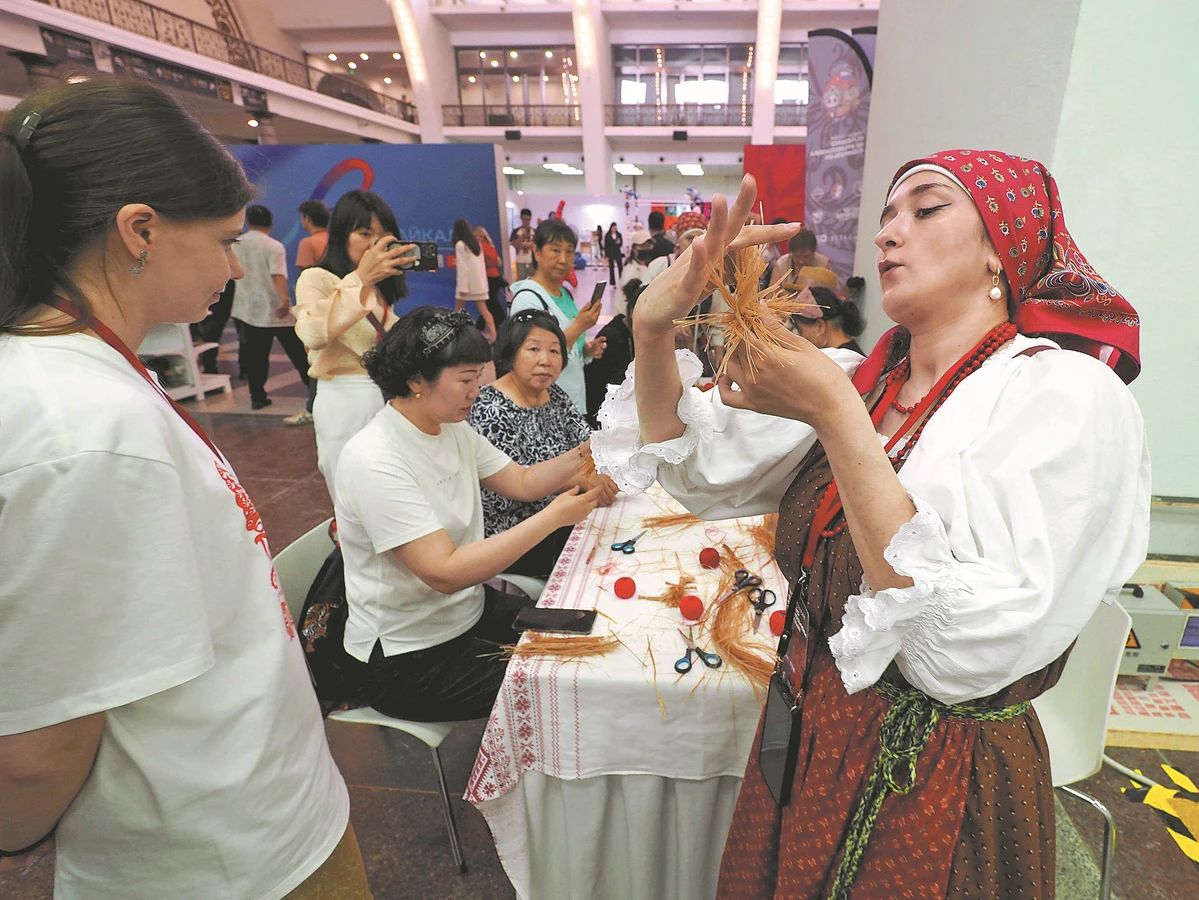
Visitors experience Russian weaving techniques during a cultural and art festival at the Beijing Exhibition Center on June 14. DU JIANPO/FOR CHINA DAILY
Nostalgia symbol
Luan Yufeng, deputy general manager of the Beijing Exhibition Center Co Ltd, said: "The nickname stems from the restaurant's long history and its special place in the hearts of Beijing residents or those born in the last century. Almost everyone knows about the Moscow Restaurant. For many, Lao Mo is more than just a restaurant; it's a cherished symbol of nostalgia and a witness to the city's development and changes in recent decades."
The Moscow Restaurant, which opened in October 1954 next to the Beijing Exhibition Center, was the capital's first high-end Russian restaurant. It is the place where many had their first taste of Western cuisine. In a specific historical context, the Moscow Restaurant left an indelible mark, carrying the memories and feelings of a generation.
"The restaurant's unique Russian paintings and artist performances provide Beijingers with a window into Russian culture," Luan said. "It has also hosted many guests from Moscow, fostering friendship and interaction between the people of the two cities."
Of course, cultural exchanges between Beijing and Moscow come in many more forms than in transport and gastronomy. For example, through dynamic exchanges in tourism and education, Beijingers and Muscovites are gaining deeper insights into each other's worlds, igniting an enthusiasm for cross-cultural communication.
Russia's Sputnik news agency said that in the 2024-25 academic year, 98 primary and secondary schools in Moscow had introduced Chinese-language courses. The Moscow government said more than 16,000 of its residents are learning Chinese, reflecting a growing interest in the language and the Chinese culture.
Andrey Karyakin, deputy director of the Russian-Chinese International School in Moscow, said that over the past decade, the number of Russians studying Chinese has risen sevenfold.
"The remarkable thing is that some Russian children already have a basic grasp of the language when they enroll for the school. Parents encourage their children to speak Chinese, confident in the bright future of tourism and economic exchanges between the two countries."
In the first eight months of this year, Beijing had 179,254 visits by Russian tourists, almost four times the number for the corresponding period of 2023, the data from the Beijing Municipal Bureau of Culture and Tourism showed. This surge has helped place Russia at the forefront of European tourists visiting Beijing.
Romadina said some of her friends in Beijing have turned this influx into a thriving business, organizing itineraries for Russian visitors. During peak tourist season it is not uncommon for them to earn up to 1,000 yuan ($140) a day, she said. She sees the rising number of Russian tourists in Beijing as evidence of the strength of relations between the two cities and the two countries.
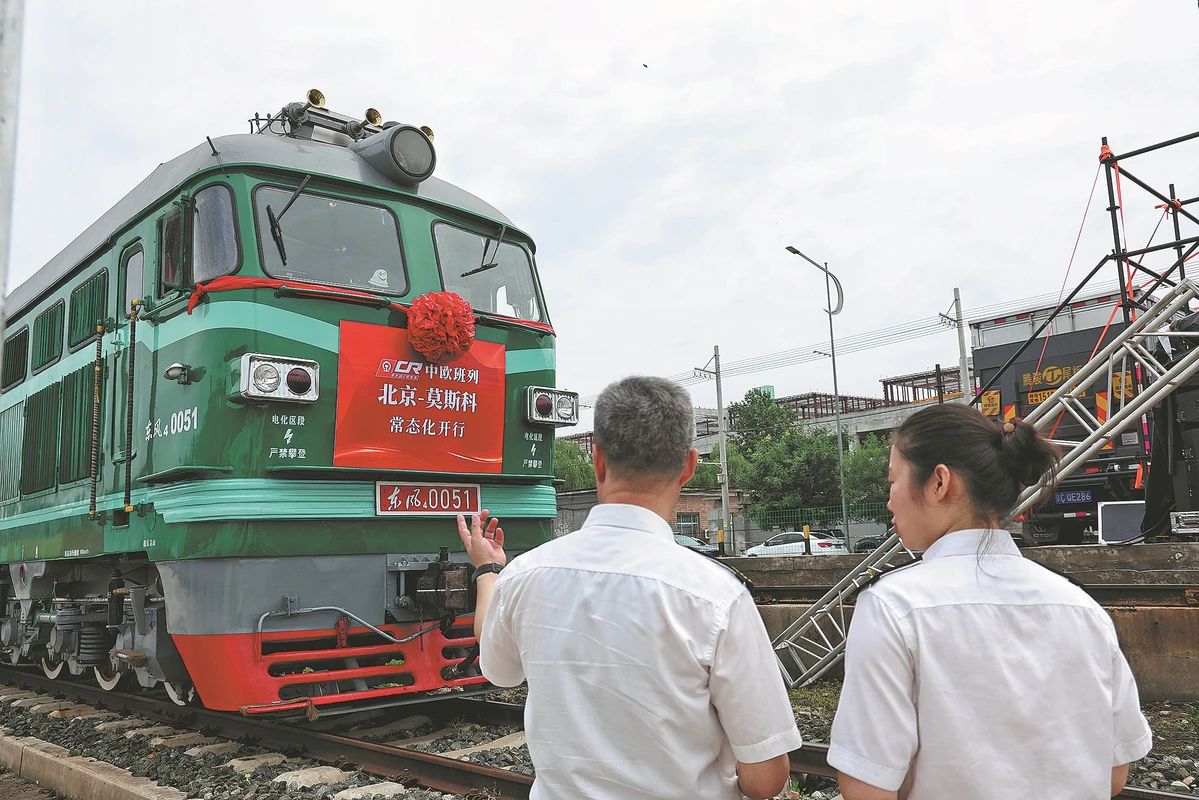
A freight train departs for Moscow from Beijing's Mafang Station in Pinggu district on July 1. PHOTO PROVIDED TO CHINA DAILY
Mutual visits
Xiong Jiuling, director-general of the Foreign Affairs Office of the People's Government of Beijing Municipality, said: "As early as the 1950s government delegations from Beijing and Moscow conducted mutual visits. In 1957 the Moscow Zoo welcomed the giant panda Ping Ping from Beijing Zoo, the first time China's national treasure had traveled abroad, becoming a symbol of friendly exchanges between the two countries.
"Russian culture is an indelible memory for older Beijingers through classic songs such as Moscow Nights and Katyusha, and Russian-style architecture such as the Beijing Exhibition Center and Moscow Restaurant are part of modern Beijing, and are now a big draw for young people."
Since sister-city ties were established nearly 30 years ago, Beijing and Moscow have continually expanded the areas in which they work together, she said.
"Moscow is one of Beijing's most important sister cities, with leaders from both cities placing great importance on developing their relationship. The two have signed 13 cooperation agreements at the municipal level, most of them lasting three years."
In June, Beijing's Party Secretary, Yin Li, and the Mayor, Yin Yong, met the Mayor of Moscow, Sergey Sobyanin, in Beijing to discuss future collaboration, culminating in a new cooperation plan for 2024-26.
During the visit, Sobyanin lauded the long-standing sister-city relations and said that the two cities have a lot of things in common. Moscow is ready to work more closely with its sister city to achieve even greater results in areas such as economics and trade, transportation, education, healthcare, tourism and smart city development, Sobyanin said.
The following month, the China-Europe freight train (Beijing-Moscow) departed from the comprehensive logistics hub in the Pinggu district of Beijing. The train, loaded with 55 containers of goods such as home appliances, clothing and building materials, marks the normalization of direct freight train services between the two cities. The train is scheduled to run four times a month.
"Next year's 30th anniversary of the sister-city relationship will be a new starting point for the development of their sister-city relations," said Xiong of the Foreign Affairs Office of the People's Government of Beijing Municipality.
Beijing plans to strengthen intergovernmental exchanges with Moscow, deepen collaboration in scientific and technological innovation and promote cultural exchanges, she said.
"We will take full advantage of the China-Russia Year of Culture and the 30th anniversary of Beijing-Moscow sister-city relations to host more cultural, tourism, sports and art exchange activities with Moscow to better promote mutual understanding and friendship between the people of the two countries and cities."
